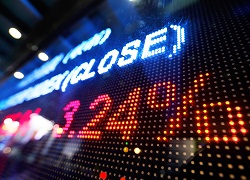 From the USA the number of job openings referred to as jolts came in in line with expectations at 4 million on Tuesday according to the latest data from the USA BLS department. This encouraging news was also supported by wholesale inventories in the USA which grew by 0.4% in the month of January, versus 0.3% in December 2013. However, this news was not enough to stop the main indices sliding into negative territory with the DJIA closing down by 0.41% on the day, the second day of consecutive losses.
From the USA the number of job openings referred to as jolts came in in line with expectations at 4 million on Tuesday according to the latest data from the USA BLS department. This encouraging news was also supported by wholesale inventories in the USA which grew by 0.4% in the month of January, versus 0.3% in December 2013. However, this news was not enough to stop the main indices sliding into negative territory with the DJIA closing down by 0.41% on the day, the second day of consecutive losses.
Discouraging news for the USA came in the form of the latest small business survey with the NFIB latest Index dropping 2.7 points to 91.4, a reading that historically has been associated with recessions and periods of sub-par growth.
This sub-par growth of small business optimism has obviously been missed by the OECD who appear to have a blind spot in relation to how the G7 countries are recovering. Perhaps the biggest blind spot relates to the extra liquidity of thirty trillion USD ‘created’ by global banks we reported on yesterday (courtesy of the BIS) which still hasn’t been enough to kick start a sustained recovery. The OECD believes that the USA economy is recovering as is the UK, it describes the EU recovery as patchy and Japan’s as lagging.
On the subject of the UK economy an economic think tank, the NIESR believes the UK recovery is strong, but curiously they appear to think that the UK’s GDP growth will stall in 2015, just after the UK next election…
NIESR Estimates of Monthly GDP
Our monthly estimates of GDP suggest that output grew by 0.8 per cent in the three months ending in February after growth of 0.7 per cent in the three months ending in January 2014. This implies that output is less than 1 per cent below its pre-recession peak (January 2008) and we expect this peak will be recovered over the course of 2014. We do not anticipate that the Bank of England’s MPC will adjust interest rates until the second quarter of 2015. Note: NIESR’s latest quarterly forecast (published 7th February 2014) projects GDP growth of 2.5 per cent per annum in 2014 and 2.1 per cent in 2015.
US Wholesale Inventories Rise
January Wholesale Inventories for the US have just been announced at 0.6%. The market had only expected a rise of 0.4%, slightly up on December’s figure of 0.3%. This figure captures the level of goods that have been produced in the US but are waiting for onward sales. In essence if this figure is rising it is indicative of a slowing in the US economy as it accounts for delayed or cancelled sales. The production process will quickly adjust to keep this figure around it’s long term average of 0.5% implying that market moving information is really only discernible when this number deviates from the norm for more than two consecutive months.
U.S. Job Openings and Labor Turnover Survey News Release
There were 4.0 million job openings on the last business day of January, little changed from December, the U.S. Bureau of Labor Statistics reported today. The hires rate (3.3 percent) and separations rate (3.2 percent) were little changed in January. This release includes estimates of the number and rate of job openings, hires, and separations for the non-farm sector by industry and by geographic region. The release also includes 2013 annual estimates for hires and separations. The annual levels for hires and quits increased in 2013 while the annual total for layoffs and discharges decreased.
Uncertainty Continues to Be the Enemy of US Small Businesses: NFIB
Small business optimism continues its winter hibernation with the latest Index dropping 2.7 points to 91.4, a reading that historically has been associated with recessions and periods of sub-par growth. The one highlight in the January survey, a surge in hiring plans, was crushed in February by the continued onslaught of a wintry recovery now in its 5th year. “Uncertainty is a major cause of the Index’s dip. Lacking any progress in Washington and facing continued unknowns with the healthcare law, the EPA, the minimum wage, tax reform and more, it is no surprise that the Small Business Optimism Index fell.
OECD: Recoveries continuing in G7 countries, emerging economies are mixed
Recovery is under way in the world’s advanced economies, underpinned by supportive financial conditions and reduced drag from budgetary tightening, but activity in the major emerging markets is mixed, according to the OECD’s latest Interim Economic Assessment. The recovery is advancing well in the United States and the United Kingdom, but proceeding more unevenly in Japan and still lagging behind in the euro area. A series of one-off factors – severe winter weather in North America and anticipation of an April 1st rise in Japanese consumption tax – have led to an uneven pace of growth.
Market overview at 10:00 PM UK time
The DJIA closed down 0.41%, SPX down 0.51%, NASDAQ down 0.63%. Euro STOXX closed down 0.01%, CAC down 0.48%, DAX up 0.46%, FTSE down 0.06%. The DJIA equity index future is down 0.47%, SPX future down 0.64%, NASDAQ down 0.51%. The euro STOXX future is down 0.03%, DAX future up 0.36%, CAC future down 0.66% and the UK FTSE future is down 0.20%.
NYMEX WTI oil finished the day down 1.60% at $99.50 per barrel, NYMEX nat gas down 0.92% at $4.61 per therm, COMEX gold was up 0.58% at $1349.20 per ounce, with silver down 0.29% at $20.85 per ounce.
Copper futures for May delivery dropped 2.6 percent to $2.9525 a pound on the Comex in New York, after touching $2.942, the lowest for a most-active contract since July 2010. Copper has tumbled 13 percent this year, the most among 34 commodities tracked by Bloomberg.
Forex focus
The yen appreciated 0.2 percent to 103.02 per dollar early evening in New York after gaining earlier as much as 0.4 percent. The Japanese currency strengthened 0.4 percent to 142.78 per euro. Europe’s shared currency weakened as much as 0.3 percent to $1.3834 before trading at $1.3860, down 0.1 percent. It rose on March 7th to $1.3915, the highest since October 2011. The yen gained for a second day versus the dollar on demand for safety as stocks and commodities fell amid concern about instability in China’s financial system.
Sterling dropped 0.1 percent to $1.6632 late afternoon London time after rising to $1.6786 on March 7th, the strongest level since Feb. 17th. The U.K. currency was at 83.36 pence per euro after weakening 1.5 percent in the previous three days. Analysts have increased their year-end forecasts for the pound against the dollar to the highest in more than two years amid speculation the Bank of England will increase interest rates before the Federal Reserve.
Bonds briefing
The 10-year yield fell one basis point, or 0.01 percentage point, to 2.77 percent late evening in New York after rising as high as 2.80 percent. It reached 2.82 percent on March 7th, the highest level since Jan. 23rd. The 2.75 percent security rose 2/32 or 63 cents per $1,000 face amount, to 99 27/32. Yields traded in the tightest range since Feb. 10th. They rose 14 basis points last week, the most since the five days ended Sept. 6th. Current three-year note yields were little changed 0.76 percent. Treasuries rose a second day as demand at the government’s auction of $30 billion in three-year notes was bolstered by the highest yields in six months and investors seeking a haven in the world’s most liquid assets.
Fundamental policy decisions and high impact news events for March 12th
Wednesday sees the publication of the home loans in Australia, expected in up 0.8% month on month. Japan publishes its consumer confidence print, expected in at 40.3, whilst the BOJ publishes its monetary policy details.
The UK’s trade balance for the month is expected to come in at -£8.7 bn. whilst the industrial production figure for Europe is expected in at 0.6% up month on month. From the USA the Federal budget balance is expected to come in at the worse for three years at -$223 billion. Shortly after treasury secretary Lew speaks.
New Zealand’s cash rate is expected to remain at 2.5%, a statement from the RBNZ then follows regarding the decision plus an explanation of the bank’s current monetary policy. Core machinery orders from Japan are finally published, expected to come in at 7.3% up.





